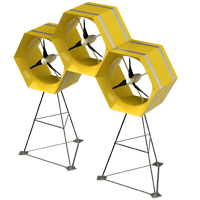Robotic squid and honeycomb turbines
Undergraduate students from the Department of Mechanical and Process Engineering (D-MAVT) have once again given their all and in late May will be presenting 11 new projects developed over the past year. ETH News takes a closer look at two of them.
In the fifth and sixth semesters, undergraduate students deepen their overall skills base and set a focus. What sounds like the humdrum quotidian life of a student culminates for the future mechanical engineers in a highly regarded and popular educational event. Each year they present their focus projects and this year's results are particularly prolific: Eleven groups will demonstrate new robots, motors, turbines and other developments.
Sepios loops the loop
The combination of robotics and bionics is tempting for any engineer. So it’s no wonder that Martin Möller, project coordinator of Sepios, quickly found eight colleagues who were willing to work together to build an underwater robot that mimics the movements of cuttlefish and squid. Sepios’ hull comprises a polycarbonate cylinder that houses the control electronics and batteries. Up to four modular fins can be attached and removed from the cylinder as needed. Small rods along each fin move an elastic foil in a wave-like undulating motion, enabling Sepios to move gracefully through the water. The robot swims – as is typical for its role model, the cuttlefish – equally well backwards and forwards, and can rapidly decelerate and accelerate in the other direction. Each dive teaches the students more and Sepios is now capable of doing loops and twists in the water.

Since it is so agile, in future the underwater robot should be able to navigate through narrow pipes and openings, and as it does not have a propeller it is less likely to get caught in seaweed or disturb sensitive animals. For now, Sepios can dive to a maximum depth of only five metres in the pool, but the construction of a more robust prototype is feasible. Its builders are well aware of the potential of Sepios, but they are, first and foremost, enthusiastic students: “For now, Sepios is a research project,” says Möller. “It's a long way from becoming a commercial product.” Some day, Sepios could potentially be used to investigate shipwrecks and underwater caves, film sea creatures or serve as a diving assistant in offshore applications.
Lift-ready honeycomb for flat roofs
Everyone knows about the offshore wind farms in the North Sea, but how can wind power be used effectively in the city? The students of the Urban Flow group studied the question intensively with the aim of making a real contribution to the development of sustainable energy sources. The students examined airflow conditions in the city, where wind is accelerated by streets and buildings in many places. Based on this analysis and in consultation with architects, they quickly settled on the ideal location for a new turbine: a flat rooftop. Since urban areas call for solutions that are both visually appealing and flexible, the group’s first goal was to find a small modular solution that could be transported to the roof in a lift. The students’ idea of a honeycomb structure is ideal because it concentrates the wind, enabling the turbine to work more efficiently.

The hexagonal honeycomb structure, called Honeycomb, is made of fibreglass-reinforced plastic. For the rotor, the students used a lightweight carbon fibre. The turbine is held together by a steel frame and securely fastened to the roof on a tripod. These metal parts make up most of the weight – a module weighs just 120 kg. A wind turbine product from Urban Flow produces a nominal output of 400 watts; in comparison, the same output would require roughly two square meters of solar panels. The Urban Flow group does not regard the Honeycomb as a rival to the solar cell, but rather a useful supplement. “In many places there's not enough sunlight or the wind has greater potential. That has to be ascertained in each location,” says Vanessa Schröder of Urban Flow. Now the honeycomb turbine will be tested on the roof of the University of Applied Sciences HTW in Chur. Schröder is looking forward to the trial: “We’re very excited to see whether the turbine works in practice. If so, that would be a great reward for an incredibly diverse development process – particularly for undergraduate studies.”
Focus projects rollout
A total of eleven groups will present their focus projects to the public on 27 May 2014. The presentations will be held between 2 pm and 4 pm in the AudiMax (HG F 30). Afterwards, all projects will be displayed in the main hall of the ETH main building. Further information: mavt.ethz.ch

Comments
No comments yet